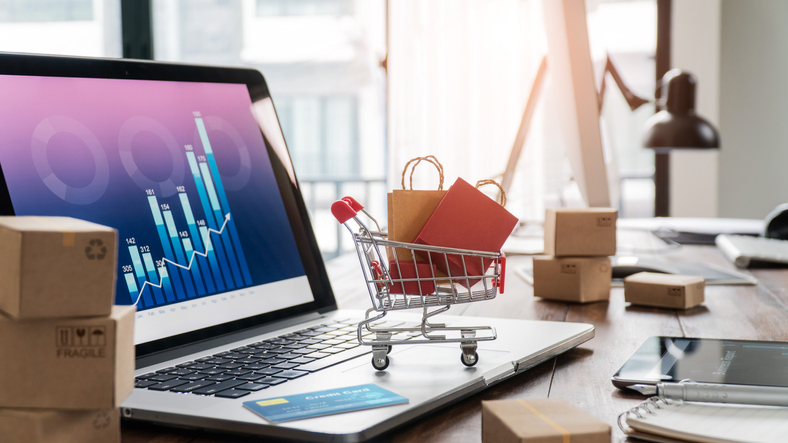
Dec
A Year of Change Brings New Trends
The past year brought significant change to countless industries around the world in multiple ways. On the consumer side, the global shift to e-commerce spending — up 4% year-over-year and growing almost twice as fast — has put immense pressure on manufacturers, distributors, and carriers to meet that demand in a timely fashion, with particular strain felt in last-mile delivery.
On the business end, teams that were once working together in the office had to learn to function separated from one another. Leadership teams had to quickly shift priorities to sustain their organizations and navigate through shutdowns. Operations teams faced new challenges in keeping their companies running smoothly. And supply chain and logistics teams have had to navigate through lengthy delays, a transportation capacity crisis, and more.
But the pandemic has also spurred on several new trends that companies are leveraging (and indeed have been leveraging for some time) to achieve their logistics and supply chain goals. Let’s explore some of these trends and how you and your clients can put them to work in the new year.
3 Trends to Achieve Your Clients’ Logistics and Supply Chain Goals
1. Leveraging Technology
Putting tools and systems to work for your clients’ success is no simple feat, yet the rewards in terms of efficiencies, reporting, identifying the best opportunities, and more make the effort worthwhile. In the new year, leveraging technology to help achieve your clients’ logistics and supply chain goals will be essential.
Examples include the adoption of blockchain throughout your clients’ supply chain networks to build trust between suppliers and partners, increase transaction transparency, identify opportunities for improvement, and help them maintain compliance with trade regulations.
Other trends include leveraging automation in all its forms, from working to establish more advanced warehouse management systems to leveraging tools that teams can use to make orders, carrier management, and other aspects of logistics and supply chain more efficient. In this same vein are smart contracts and communications, which automate many of the essential functions of a supply chain or logistics transaction. This might include automatic invoice submission or notification emails based on a timeline.
A final component here is the layering of these technologies wherever and whenever possible. This should be one of your clients’ primary logistics and supply chain goals for 2021: gaining greater value from their tech stack while identifying opportunities to improve and streamline the results.
2. Increasing Transparency
While we’ve already touched on transparency via blockchain and certain automation technologies that enable greater visibility into transactions and processes, transparency itself will continue to be a growing trend for organizations worldwide. Your clients must have greater insight into who they’re working with, the myriad details of their transactions, and how to use that information for more effective decision-making in 2021.
Two immediate recommendations for the new year include improving data quality and leveraging IoT-enabled devices. On the data quality side, ensuring that the information your clients are working with is accurate will be paramount to success. Effective decisions — both at the tactical and strategic levels — won’t be successful if they’re based on a foundation of inaccurate data and reporting.
And on the IoT side, companies leveraging various devices throughout warehouses, their fleets, and other areas of the business must be able to derive some understanding of how their business is working through those devices. [Mobile device management (MDM) solutions](https://www.trgsolutions.com/resources/blog/march-2020/4-reasons-to-use-managed-uem-mdm-services) provide incredible insights into how an organization is running its operations, communicating, and ultimately gaining the most value from its devices.
3. Building Partnerships
Just as companies are leaning on outsourced technology solutions for greater data management, reporting, and communications, a key trend in achieving logistics and supply chain goals in 2021 will be working with expert 3PL providers. The critical advantage of 3PL partners is that they enable supply chain teams to focus on other key business objectives without getting mired down in the day-to-day details. They also help companies focus on delivering the best possible service to their customers because they can focus on building their strengths. If your clients cannot utilize a 3PL in 2021, they can at least focus on matching the key traits of such service providers: continuous improvement, leveraging technology, and increasing supply chain efficiency.
Beyond the daily execution of logistics and supply chain goals, another trend for 2021 is an ongoing effort to optimize performance across the board. While technology, data, and other processes enable some insight from within the organization, your clients stand to gain the most value by working with a trusted advisor that understands logistics and supply chain operations at the expert level — who lives and breathes these functions every day. Logistics and supply chain optimization firms are adept in identifying key metrics that are essential to your clients’ success and tailored to their unique industry and goals.
Drive Real Results and Achieve Supply Chain Goals with Brady Partners in 2021
Brady Partners is the advisory partner your clients need to maximize their logistics performance and realize their financial and operational goals. As a trusted advisor to banks, accounting firms, and other organizations that support long-term success for their clients, we’re uniquely positioned to evaluate your clients’ logistics function for success in 2021. We’ll partner with you to ensure your clients’ senior leadership understands the importance of these trends for achieving their logistics and supply chain goals in the new year.
It all starts with our complimentary health check, in which we evaluate your clients’ performance to date and provide key takeaways where improvement is possible. From there, our team works with the client to consistently monitor and improve logistics and supply chain metrics, ultimately leading toward significant savings and better operational performance.

